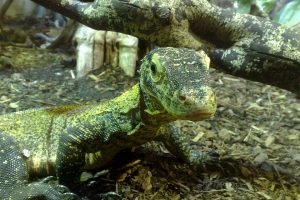Published on BBC Earth’s Facebook page the 01.08.2019.
Playing reptiles? Unthinkable up until this groundbreaking study on Komodo dragons, which wouldn’t have been possible without modern zoos and aquariums.

Note: Now you can ask yourself, what the use of discovering this playing behaviour is. First, it radically changes the view we have of reptiles and second, it helps us to understand their behaviour. Komodo dragons are classified as endangered and to be able to help them, we need to understand their behaviour. And, what’s more, the presence of playing behaviour is also used as an indicator of well-being, through which we can optimise husbandry conditions.
Reptiles are considered boring, dangerous or brutal and that’s why some people don’t like them. The detection of playing behaviour however, makes them more likeable and opens people up for emotional bonds to the animal, important for sparking the motivation to help with protective campaigns. The importance of such emotional bonds to a species, is becoming increasingly clearer when it comes to engaging in its conservation – now, you might find this to be wrong or criticise it, but it doesn’t change the facts: playing behaviour makes animals more likeable to humans.
The presence of playing behaviour also offers the opportunity to implement training into the care, which can be presented educationally to visitors and bring the species closer them. Most visitors are interested in those animals presented to them in an entertaining manner, it’s just difficult to captivate people with animals that spend their time mostly resting. If, however, they can experience them in action and interaction, it is much more likely that they will be interested in them, and animal-friendly training offers some wonderful possibilities here.
